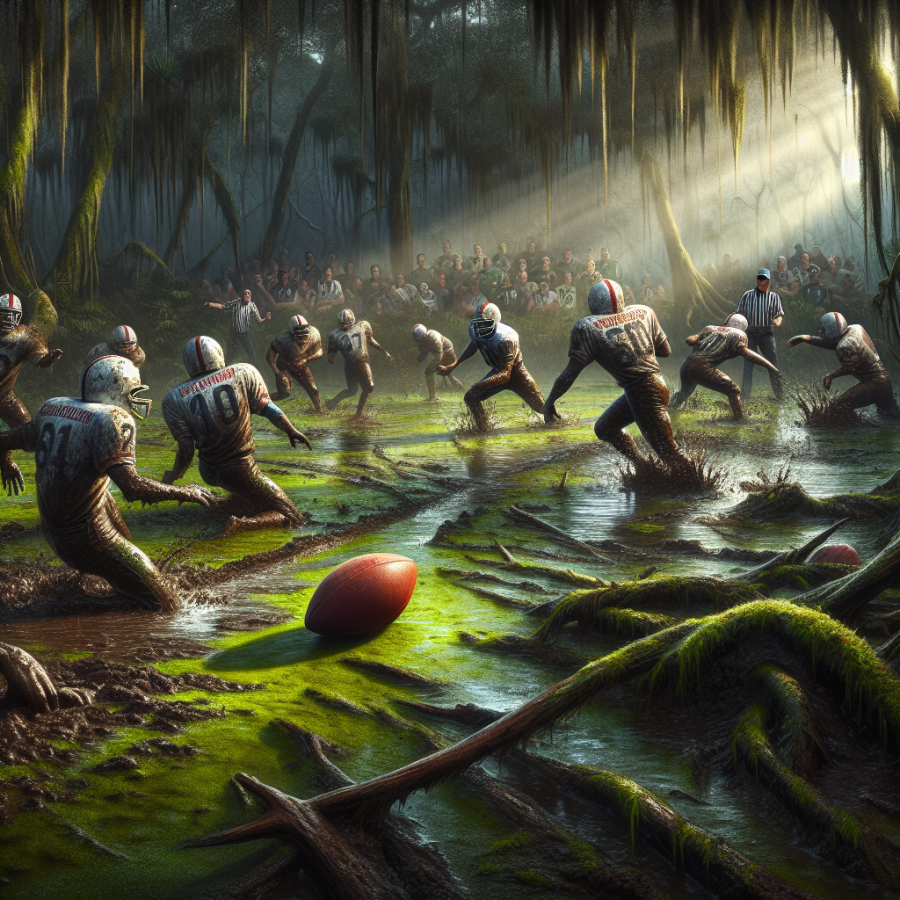Trudging Through Muck: The Rise of Swamp Football
In the heart of the wet and wild marshlands, a new sport has taken root that combines the love of traditional football with the sloppy, unpredictable conditions of a swamp. Swamp football, or swamp soccer, as it's sometimes known, is a growing phenomena that adds an extra layer of challenge and hilarity to the well-loved sport.
Originating in the bogs of Finland where it was conceived as a training exercise for athletes, swamp football has quickly evolved into a serious competition with teams trudging through thick mud to make their plays. Unlike its conventional counterpart, this version of football sees players navigating not only opposing teams but the formidable natural elements of a swamp.
Swamp football pitches are nothing like the manicured green turfs you might be accustomed to. Here, players are knee-deep in muck, a circumstance that dramatically alters the dynamics of the game. The playing field, typically 60 by 35 meters, is filled with natural obstacles such as hidden dips, uneven terrain, and thick mud that can suck a player's foot down like quicksand. The unpredictable field conditions are a leveler, making the game more about fun, teamwork, and strategy than about speed or finesse.
Rules in swamp football have been tweaked to ensure safety and to adapt to the viscous playing field. Teams are generally smaller, with six players on each side, allowing for more movement in the mire. Physical contact is pared down, and matches are shorter, usually consisting of two 13-minute halves to avoid overexertion in the exhausting conditions.
The balls used in swamp football are standard, but they behave in erratic ways when punted into the gooey terrain. This unpredictability makes scoring more difficult and every goal earned through perseverance and grit. Defending too is a challenge, as players have to move quickly and strategically in terrain that fights against swift movements.
One of the most exciting aspects of swamp football is its inclusivity. The sheer messiness and quirkiness of the sport dispose of any pretensions. Instead of sleek athleticism, the emphasis is on participation and enjoyment. This makes the sport accessible to people of various ages and fitness levels. Within the muck and mire, everyone finds common ground.
Swamps aren't known for being hospitable places, and yet, they provide a home for this eccentric sport that's all about the fun of the game. Matches often end with players indistinguishable, covered head to toe in mud, and smiling broadly.
Read also:
Maximizing Fitness Results: A Comprehensive Guide to Exercise Drills
Strategies and Challenges of Playing Football in the Swamps
Swamp football, or swamp soccer, presents an array of unique strategies that teams must consider due to the unconventional playing environment. Unlike traditional football played on grass pitches, swamp football is played on muddy, waterlogged ground, typically in areas that were once swamps or bogs, and this significantly influences tactical decisions.
**Agility and Stamina:** Players must adapt their usual style of play to account for the difficult terrain. Agility and stamina become crucial as maneuvering through thick mud is physically demanding and requires additional strength and energy. Traditional dribbling and sprinting techniques are largely impractical, so players often resort to a more conservative energy conservation strategy. Players also need to develop balance and a sense of stability to avoid slipping and falling, which is common in swamp football.
**Ball Control:** Controlling the ball in swamp football is highly challenging due to unpredictable movements caused by the soft and uneven terrain. Players must demonstrate exceptional ball control to keep possession, often using simpler, more controlled touches. As the ball is prone to getting stuck in the mud, passing and shooting require more force, and accuracy becomes harder to maintain.
**Teamwork and Communication:** Given the physically taxing nature of the sport, effective teamwork and communication are essential. Players need to work together to traverse the muddy terrain while conserving energy. Quick, vocal coordination is necessary to move the ball efficiently across the field, as visual cues can be unreliable in such a chaotic environment.
**Adapted Equipment:** Footwear is particularly important; regular football cleats are often insufficient for swamp football. Players may use gear adapted to the conditions, with boots designed for extra traction in mud or specialized gear to keep warm in the often chilly swamp environments.
**Challenges:**
**Injury Risks:** The risk of injury is heightened, as the unstable ground increases the potential for twisted ankles or knees. Players need to be specially trained to handle the physical demands of the game and to avoid injury due to the uneven playing surface.
**Weather Dependence:** The condition of the swamp or bog can change rapidly with the weather, making the level of difficulty highly variable. A sudden downpour can turn a moderately muddy field into a quagmire, while a dry spell could make the surface unexpectedly firm, changing the dynamics of play.
**Hygiene Concerns:** Playing in swampy conditions raises hygiene concerns since standing water may harbor bacteria and parasites. Ensuring player safety requires attention to cuts or abrasions and proper cleaning post-game to prevent infections.




